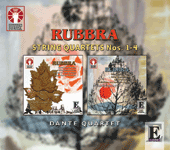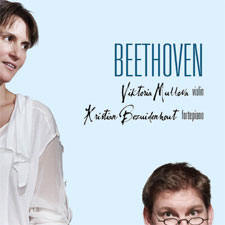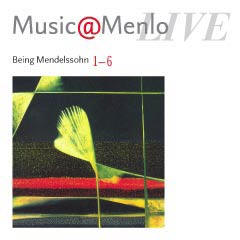You are reading the older HTML site Positive Feedback ISSUE 49may/june 2010
Notes of an Amateur:
Rubbra, Beethoven, and Music@Menlo, 2009.
Rubbra, String Quartets 1-4. The Dante Quartet. Dutton Laboratories. LX Box 2010. The English have taken a long time to accommodate modernism and have never been entirely comfortable with it. Britten is about as far as they were able to go with any enthusiasm for much of the twentieth century. It's probably too soon to say whether the recent prominence of Thomas Adès and increased acceptance of the likes of Michael Tippett, Peter Maxwell Davies, Harrison Birtwhistle, Brian Ferneyhough, and John Pickard signals a change; but if the annual Aldeburgh Festival has any real influence beyond Suffolk, perhaps. At any rate, except for Britten and some interesting exceptions like Elizabeth Maconchy, who (quietly) wrote thirteen variously compelling modernist string quartets between 1932 and 1984, English music for the greater part of the twentieth century was stubbornly pre-modernist, exploring ways to keep the familiar world of late romanticism alive in a world that, at least at the level of high culture, had largely passed it by. The good news for music history is that some of the conservative forces produced some truly good music. Edmund Rubbra (1901-1986) is one of these. As late as the mid 1970's, he was composing symphonies and especially chamber music that speak with power from outside the modernist mainstream. This new two CD reissue of recordings made in 2000-2001 by the sound masters of Dutton Labs and engineered by legendary recording engineer Tony Faulkner, provide a strong sample of Rubbra's chamber music from the 1940's through the 1970's. The album focusses mainly on his four string quartets, but also includes two works written for cellist and friend, British cellist Anthony Pleeth, and a wonderful duo for two violas. Listening to this music, I am more than ever disappointed with modern chamber music programmers who insist on restricting their fare to the works of well-known composers, music many of us hear often in concerts, on FM radio, and on recordings from the major labels. Wouldn't it be a treat to go to a 'live' concert of quartets by Piston, Rubbra, and Martinü? Or David Diamond, Rubbra, and Krenek? Isn't it wonderful to have two full CD's of the chamber music of Edmund Rubbra! Quartet No. 1 (1933; rev. 1946) is more pensive and reclusive than American modern romantic music but less troubled than Britten. Toward the end of the second (middle) movement, there is a moving solo section for viola which seems to emerge from nowhere, like a mysterious bird. This music is reminiscent of the novels of Thomas Hardy, a notable late nineteenth and early twentieth century English novelist who also told melancholy tales while resisting modernism. Sonata in G Minor for Cello and Piano (1946). This is one of two works on the program for cello written for William Pleeth, the other a simple but eloquent little Improvisation for Solo Cello (1964.) This Sonata is straightforward melodic writing, rhapsodic and affecting. It has some of the richness of late nineteenth century French music but with more backbone. Pianist Michael Dussek and Dante Quartet cellist Pierre Doumenge play it as a major piece of music, making a strong case for its stature. The third and final movement ends in an Adagio fugue (!) which has nothing French about it at all! Quartet No. 2 (1951) (and No. 4 and two other smaller works) were recorded at the Snape Maltings, Britten's concert hall in Suffolk, and its rich, clear acoustics are part of the show. There are hints of English romantic Gerald Finzi's elegiac lyricism from time to time in Rubbra, though never enough to do more than remind us that both composers could channel the same uniquely English spirit when they chose to. Rubbra does so in this quartet's second movement Adagio to great effect and then closes in bolder terms. I have listened to this quartet several times and continue to find new things in it. Meditations on a Byzantine Hymn (1962). This is a duo for two violas, played by Dante Quartet musicians Judith Busbridge and Krysia Osostowicz. To hear two elegant, husky violas have at it together can be a string lover's dream. I know of no other work of this kind. Violin/Viola duos there are aplenty, the obvious soprano/alto duet. But two altos? In the hands of Rubbra they are ten and a quarter minutes of viscous joy. Quartet No. 3 (1963) makes an especially strong case for the old way of writing. It reads like a deeply felt stream of musical consciousness, moving from the deliberate and passionate to a faster paced narrative kind of writing, maintaining the same intense feeling. Quartet No. 4 (1975-77). Rubbra hasn't not been listening to his modernist contemporaries and in his last quartet he tells us he understands that they have some things to teach him, though not many. His strong late romantic voice remains strong but there is room for some dissonance and a few black notes. I think I hear a trace of Britten's influence, but Rubbra is his own man here as well. This is an exquisite work, especially its second and final movement. This is the most enjoyable release I've heard so far this year.
Beethoven, Violin Sonatas Nos. 3 and 9. Viktoria Mullova, violin; Kristian Bezuidenhout. Onyx 4050. Jos van Immerseel, well known Dutch period instrument keyboard musician and conductor (complete Mozart piano concertos, complete Beethoven symphonies) is quoted in this album's liner notes as saying that Beethoven sounds more modern on good period instruments than on modern ones. I heard the same thing in the symphonies of Brahms in the John Eliot Gardiner recordings (here and here); and music critic and historian Richard Tarushkin has said all along that the period instrument revival has always been more about a modern preference for the lean and brisk than recovering the past. Viktoria Mullova, one of our age's leading violinists, made her reputation on the modern violin playing mainly the standard violin repertoire. Over the last decade she has reportedly fallen in love with her eighteenth century Italian 'period' violin and been playing Bach, Vivaldi, and now Beethoven. I was much impressed by her CD of the Bach solo sonatas and partitas (here), and her Beethoven is more inspired madness. She tells us she can do more with this instrument in the way of capturing the composer's nearly infinite range of moods, and she must be right. These two sonatas in her hands are delicate, passionate, beautiful, bold, whispery, brilliant. It is hard to believe a violin can be this versatile—and that this music was composed at the end of the eighteenth century. Is this what it sounded like then? And is that a question anyone but an antiquarian cares about? The question to ask is, who is Beethoven really, and now? To my ears, this is surely who he is. The composer who stepped beyond Mozart, regardless of whether one feels that was necessary. This is what major artists are compelled to do to establish their own voices. That is what makes them 'major': you can't move beyond Mozart unless your imagination is as large as his. You'll want a full range, well balanced audio system to get all of this performance and recording. If you've got one, get ready for a great musical experience. Note: Mullova is so brilliant in these sonatas, it is easy to overlook the contribution of forte-pianist Bezuidenhout, which would be a mistake. He and his carefully chosen instrument are as large and virtuosic as Mullova and her violin. This album is what the period instrument/early music revival was supposed to be all about. Great music making, a great album.
Music@Menlo 2009. Being Mendelssohn. (musicatmenlo.org). Music@Menlo's 2009 festival, which took place at various venues in Menlo Park, California over a three-week run last summer, was one of the most informative of many celebrations of the composer's 200th birthday worldwide. It offered a compelling reintroduction to the composer's chamber music by presenting it in the context of the music of his contemporaries and of some of his important predecessors and heirs as well. 'Context' is a powerful way to get at an artist's work. You hear the music in terms of what it is rather than what it is about. One of the most compelling and concrete ways to get at what Shakespeare truly is, is to read his plays alongside those of Kyd, Marlowe, Jonson, and Webster. Drawing on an assemblage of established musicians, including the St. Lawrence and Pacifica Quartets, and, among others, flutist Carol Wincenc, horn player William Vermuellian, pianists Jeffery Kahane and Gilbert Kalish, violist Paul Neubauer, violinists Menahan Pressler and Eugene Drucker, most veterans of the festival—along with the festival's directors pianist Wu Han and cellist David Finckel, the festival's seventh (!) season offered a rich and rare experience. I look forward to the release of the annual CD set of the festival's proceedings each year and have yet to be disappointed. This years' set of CD's works as a coherent, informative musical experience, even for listeners who are not students of classical music. We can hear the relationships among the works, even when many of us could not describe them in musicological terms. At the heart of this six disc program are most of Mendelssohn's major chamber works, with the exception of the string quartets, which received a great many recordings in 2008 and 2009—including a fine set by the Emersons with Drucker and Finckel. Alongside these works are an early string quartet and violin sonata by Beethoven, a nonet by contemporary Louis Sporh, a piano trio by Schumann, selections from Bach's Art of the Fugue and A Musical Offering, a delightful (and unknown to me) Adagio and Fugue by Mozart played by a string quartet and bass, a piano quartet by Brahms, and as a bracing surprise: Six Bagatelles by Legeti and a recent piano trio by American composer Pierre Jalbert. The Jalbert is one of the highlights of the program. (You may remember that Jalbert wrote a Sonata for Cello and Piano for Finckel and Wu Han in 2007, which appears on their recent album for Artistled, For David and Wu Han.) What we hear as we move through this program is how Mendelssohn was like his nineteenth century contemporaries—how they all looked back to the classical and baroque music they grew up with. But more, we hear his individual voice among the others, the voice of a composer much more closely tied to his predecessors and less urgent to break free of them. Mendelssohn takes the eighteenth century into the nineteenth with consummate grace and continuity. By the time we arrive at Volume 6 and the Drucker/Pressler/Finckel performances of the Opus 49 and Opus 66 Piano Trios, which follow on a hugely engaging performance of his Opus 18 String Quintet by Scott St. John, Geoff Nuttall, Lesley Robertson, Masumi per Rostad, and Brandon Vamos at the end of Volume 5, we realize we have come to know this composer better in specifically musical ways than we knew him before. These last three works coming at the end of the program are truly transporting. This set of six CD's is available both as a package and as individual discs only from the the Music@Menlo website. Go there! www.musicatmenlo.org. System used for the audition of the CD's: Audio Note CDT3 transport and Dac 4.1 Balanced Signature. Audio Note M6 preamplifier and P4 Balanced monoblock amplifier. Audio Note E/SPe HE loudspeakers. Audio Note Pallas and Sootto interconnects; Audio Note Sogon speaker cables. Bob Neill, in addition to being an occasional equipment and regular music reviewer for Positive- Feedback Online, is also proprietor of Amherst Audio in Amherst, Massachusetts, which sells equipment from Audio Note, Blue Circle, and JM Reynaud, among others.
|



